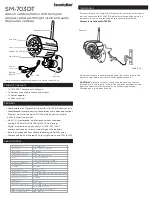
CIAS Elettronica S.r.l.
Ed 2.0
Installation Handbook
page
36
to
44
ERMUSA
f) After having loosened the fastening screws on the mast, turn the Receiver module on
the horizontal plane till obtaining the maximum reading on the
display
(2).
g) Repeat the pointing operation on the horizontal adjustment of the transmitter module.
h) After having obtained the best pointing, lock the horizontal movement of the TX and RX
modules.
i) Unlock the vertical movement of the RX module and direct it towards the top.
Slowly move it towards the bottom till obtaining the maximum reading on
display
(2)
and on the
LED
(3) by proceeding as per the horizontal adjustment.
j) Repeat the vertical movement on the TX module. After having obtained the maximum
reading, lock the vertical movement on modules TX and RX.
k) Press key
“loop”
(17) and check that Loop Closure LED
“open”
(18)
turns OFF.
Check that after a recovery period of approx. 2 mins. the value read on
display
(2)
reaches approx. 6 V
10 %, and that the LED at the centre of the bar lights up.
Note
: The absolute value precision of this test (6 V
) isn't very important, because it
doesn't depend by the absolute value of microwave (MW) received signal, but it is
related to the instrument STC 95 adjustment. On the contrary the stability of this test, is
directly related to the stability of the received microwave (MW) signal, for this reason
the instability of this test mean that the RF received signal is in some way perturbed, in
this case is necessary to check for the absence of moving object into the protected
area, or check if the received signal is too weak and so affected by large amount of
noise. In case of uncertainty check the real working condition by means of a scope
connected to RCA connector of STC 95 (see point "S").
l) Press key
“
”
(10)
till LED
“V Rag Rx”
(7) lights up. Check that a voltage value within
2,5 6,5 V . is read on the display. This AGC voltage value is directly proportional to
the distance between the transmitting and receiving heads.
m) Press key
“
”
(10) till the Sensitivity Measurement LED
“sens Rx / Tx”
(6) lights up.
Operate on the PT1 trimmer present in module RX (fig. 10) till a value within 0,5 and 9,5
V
5 % is read on the display. Note that the value of 0,5 V
corresponds to the
maximum sensitivity, and that value 9,5 V
corresponds to the minimum sensitivity.
The alarm crossing tests usually are performed with a walking person (standing) moving
at a speed of 0.5 m/s. We suggest to start this tests with the sensitivity adjusted at 50 %
(trimmer position) and the integration adjusted at 40 % (trimmer position).
The final sensitivity adjustment must be related to the specific site requirements.
Note: Too much sensitivity can cause unwanted alarms.
We suggest to adjust the
max. sensitivity at no more than 75 % (trimmer position), which correspond at about 1,6
V .
Too low sensitivity can miss alarm in case of little dimension intruder.
We suggest to adjust the min. sensitivity at no less than 25 % (trimmer position), which
correspond at about 6,7 V .
n) Adjust the PT7 trimmer on module RX (fig. 10) till obtaining the required integration
(max clockwise). The integration function act on intruder crossing speed. The alarm
crossing tests usually are performed with a walking person (standing) moving at a speed
of 0.5 m/s. The final integration adjustment must be related to the specific site
requirements.
Note: Too low integration can cause unwanted alarms.
Содержание ERMUSA 30
Страница 43: ...NOTE...








































